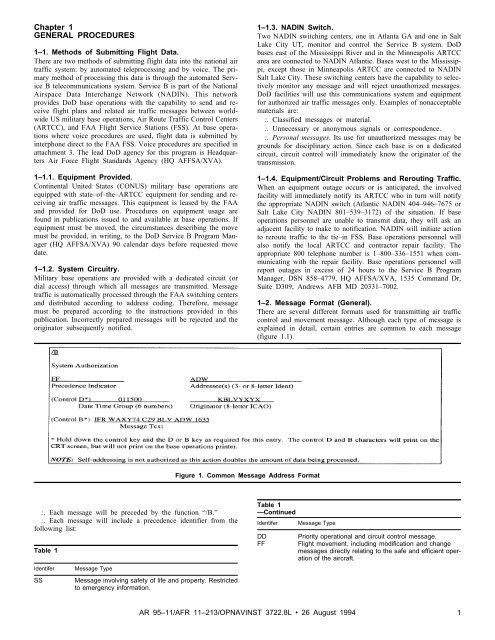military flight data tele - communications system - Army Publishing ...
military flight data tele - communications system - Army Publishing ...
military flight data tele - communications system - Army Publishing ...
Create successful ePaper yourself
Turn your PDF publications into a flip-book with our unique Google optimized e-Paper software.
Chapter 1<br />
GENERAL PROCEDURES<br />
1–1. Methods of Submitting Flight Data.<br />
There are two methods of submitting <strong>flight</strong> <strong>data</strong> into the national air<br />
traffic <strong>system</strong>: by automated <strong>tele</strong>processing and by voice. The primary<br />
method of processing this <strong>data</strong> is through the automated Service<br />
B <strong>tele</strong><strong>communications</strong> <strong>system</strong>. Service B is part of the National<br />
A i r s p a c e D a t a I n t e r c h a n g e N e t w o r k ( N A D I N ) . T h i s n e t w o r k<br />
provides DoD base operations with the capability to send and receive<br />
<strong>flight</strong> plans and related air traffic messages between worldwide<br />
US <strong>military</strong> base operations, Air Route Traffic Control Centers<br />
(ARTCC), and FAA Flight Service Stations (FSS). At base operations<br />
where voice procedures are used, <strong>flight</strong> <strong>data</strong> is submitted by<br />
interphone direct to the FAA FSS. Voice procedures are specified in<br />
attachment 3. The lead DoD agency for this program is Headquarters<br />
Air Force Flight Standards Agency (HQ AFFSA/XVA).<br />
1–1.1. Equipment Provided.<br />
Continental United States (CONUS) <strong>military</strong> base operations are<br />
equipped with state–of–the–ARTCC equipment for sending and receiving<br />
air traffic messages. This equipment is leased by the FAA<br />
and provided for DoD use. Procedures on equipment usage are<br />
found in publications issued to and available at base operations. If<br />
equipment must be moved, the circumstances describing the move<br />
must be provided, in writing, to the DoD Service B Program Manager<br />
(HQ AFFSA/XVA) 90 calendar days before requested move<br />
date.<br />
1–1.2. System Circuitry.<br />
Military base operations are provided with a dedicated circuit (or<br />
dial access) through which all messages are transmitted. Message<br />
traffic is automatically processed through the FAA switching centers<br />
and distributed according to address coding. Therefore, message<br />
must be prepared according to the instructions provided in this<br />
publication. Incorrectly prepared messages will be rejected and the<br />
originator subsequently notified.<br />
:. Each message will be preceded by the function “/B.”<br />
:. Each message will include a precedence identifier from the<br />
following list:<br />
Table 1<br />
Identifer Message Type<br />
SS Message involving safety of life and property. Restricted<br />
to emergency information.<br />
Figure 1. Common Message Address Format<br />
1–1.3. NADIN Switch.<br />
Two NADIN switching centers, one in Atlanta GA and one in Salt<br />
Lake City UT, monitor and control the Service B <strong>system</strong>. DoD<br />
bases east of the Mississippi River and in the Minneapolis ARTCC<br />
area are connected to NADIN Atlantic. Bases west to the Mississippi,<br />
except those in Minneapolis ARTCC are connected to NADIN<br />
Salt Lake City. These switching centers have the capability to selectively<br />
monitor any message and will reject unauthorized messages.<br />
DoD facilities will use this <strong>communications</strong> <strong>system</strong> and equipment<br />
for authorized air traffic messages only. Examples of nonacceptable<br />
materials are:<br />
:. Classified messages or material.<br />
:. Unnecessary or anonymous signals or correspondence.<br />
:. Personal messages. Its use for unauthorized messages may be<br />
grounds for disciplinary action. Since each base is on a dedicated<br />
circuit, circuit control will immediately know the originator of the<br />
transmission.<br />
1–1.4. Equipment/Circuit Problems and Rerouting Traffic.<br />
When an equipment outage occurs or is anticipated, the involved<br />
facility will immediately notify its ARTCC who in turn will notify<br />
the appropriate NADIN switch (Atlantic NADIN 404–946–7675 or<br />
Salt Lake City NADIN 801–539–3172) of the situation. If base<br />
operations personnel are unable to transmit <strong>data</strong>, they will ask an<br />
adjacent facility to make to notification. NADIN will initiate action<br />
to reroute traffic to the tie–in FSS. Base operations personnel will<br />
also notify the local ARTCC and contractor repair facility. The<br />
appropriate 800 <strong>tele</strong>phone number is 1–800–336–1551 when communicating<br />
with the repair facility. Base operations personnel will<br />
report outages in excess of 24 hours to the Service B Program<br />
Manager, DSN 858–4779, HQ AFFSA/XVA, 1535 Command Dr,<br />
Suite D309, Andrews AFB MD 20331–7002.<br />
1–2. Message Format (General).<br />
There are several different formats used for transmitting air traffic<br />
control and movement message. Although each type of message is<br />
explained in detail, certain entries are common to each message<br />
(figure 1.1).<br />
Table 1<br />
—Continued<br />
Identifer Message Type<br />
AR 95–11/AFR 11–213/OPNAVINST 3722.8L • 26 August 1994<br />
DD Priority operational and circuit control message.<br />
FF Flight movement, including modification and change<br />
messages directly relating to the safe and efficient operation<br />
of the aircraft.<br />
1
















